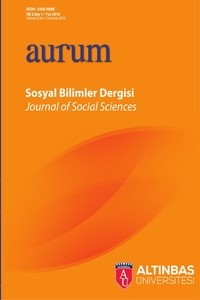Petrol Fiyatlarının Kamu ve Özel Sağlık Harcamalarına Etkisi: Orta Doğu ve Kuzey Afrika Ülkeleri Üzerine Ampirik Bir Çalışma
Bu çalışma kamu ve özel sağlık harcamaları ayrımı ile petrol fiyatlarının sağlık harcamaları üzerindeki etkisiniaraştırmayı amaçlamaktadır. Dinamik panel veri analizleri ve Granger nedensellik ve frekans-alanı nedenselliktestleri 1995-2014 yılları arasında seçilmiş on Orta Doğu ve Kuzey Afrika ülkesi için yapılmıştır. Kullanılandeğişkenlerin logaritmik birinci farklarıyla kurulan modeller ile elde edilen temel bulgular şunlardır: petrol fiyatlarıkamu ve özel sağlık harcamalarında bir etkide bulunmazken; döviz kuru oranı kamu sağlık harcamalarıüzerinde pozitif, GSYH ve enflasyon oranı da özel sağlık harcamaları üzerinde pozitif ve negatif etki göstermektedir.
Anahtar Kelimeler:
Sağlık Harcamaları, Petrol fiyatları, Orta Doğu ve Kuzey Afrika ülkeleri
THE IMPACT OF THE OIL PRICES ON PUBLIC AND PRIVATE HEALTH EXPENDITURES: EMPIRICAL ANALYSIS ON MENA COUNTRIES
This paper aims to investigate the impact of the oil prices on health expenditures, while distinguishing publicfrom private healthcare services. To analyze the impact of oil prices, dynamic panel data analysis and Grangercausality tests in time and frequency domain analysis are carried out respectively for selected ten countriesin the Middle East and North Africa (MENA) for the period of 1995 – 2014. The main findings that modeledwith log difference of the used variables are as follows: oil prices have no impact on the public and privatehealth expenditures in the dynamic models. The exchange rate has positive impact on public health expenditures,while the inflation rate has negative and the GDP has positive impact on private health expenditures.
Keywords:
Health expenditures, Oil Prices, MENA Countries,
___
- Acemoglu, D., Finkelstein, A., & Notowidigdo, M. J. (2013). Income and health spending: Evidence from oil price shocks. Review of Economics and Statistics, 95(4), 1079-1095.
- Arellano, M., & Bond, S. (1991). Some tests of specification for panel data: Monte Carlo evidence and an application to employment equations. The review of economic studies, 58(2), 277-297.
- Arellano, M., & Bover, O. (1995). Another look at the instrumental variable estimation of error-components models. Journal of econometrics, 68(1), 29-51.
- Breitung, J., & Candelon, B. (2006). Testing for short-and long-run causality: A frequency-domain approach. Journal of Econometrics, 132(2), 363-378.
- Brown, S., Hole, A. R., & Kilic, D. (2014). Out-of-pocket health care expenditure in Turkey: Analysis of the 2003–2008 Household Budget Surveys. Economic Modelling, 41, 211-218.
- Darby, M. R. (1982). The price of oil and world inflation and recession. The American Economic Review, 72(4), 738-751.
- Dickey, D. A., & Fuller, W. A. (1979). Distribution of the estimators for autoregressive time series with a unit root. Journal of the American Statistical Association, 74(366a), 427-431.
- Dizaji, S. F. (2014). The effects of oil shocks on government expenditures and government revenues nexus (with an application to Iran’s sanctions). Economic Modelling, 40, 299-313.
- El-Anshasy, A., Bradley, M. D., & Joutzl, F. (2005). Evidence on the role of oil prices in Venezuela’s economic Performance: 1950-2001. Working Paper, University of Washington.
- Farzanegan, M. R., & Markwardt, G. (2009). The effects of oil price shocks on the Iranian economy. Energy Economics, 31(1), 134-151.
- Filmer, D., & Pritchett, L. (1999). The impact of public spending on health: does money matter?. Social science & medicine, 49(10), 1309-1323.
- Geweke, J. (1982). Measurement of linear dependence and feedback between multiple time series. Journal of the American statistical association, 77(378), 304-313.
- Govindaraj, R., Chellaraj, G., & Murray, C. J. (1997). Health expenditures in Latin America and the Caribbean. Social Science & Medicine, 44(2), 157-169.
- Granados, J. A. T., & Rodriguez, J. M. (2015). Health, economic crisis, and austerity: a comparison of Greece, Finland and Iceland. Health Policy, 119(7), 941-953.
- Granger, C. W. (1969). Investigating causal relations by econometric models and cross-spectral methods. Econometrica: Journal of the Econometric Society, 424-438.
- Hall, R. E., & Jones, C. I. (2007). The value of life and the rise in health spending. The Quarterly Journal of Economics, 122(1), 39-72.
- Hamilton, J. D. (1983). Oil and the macroeconomy since World War II. Journal of political economy, 91(2), 228-248.
- Hitiris, T., & Posnett, J. (1992). The determinants and effects of health expenditure in developed countries. Journal of Health Economics, 11(2), 173-181.
- Im, K. S., Pesaran, M. H., & Shin, Y. (2003). Testing for unit roots in heterogeneous panels. Journal of Econometrics, 115(1), 53-74.
- Jaba, E., Balan, C. B., & Robu, I. B. (2014). The relationship between life expectancy at birth and health expenditures estimated by a cross-country and time-series analysis. Procedia Economics and Finance, 15, 108-114.
- Leu, R. E. (1986). The public-private mix and international health care costs. Public and private Health Services, 79(2).
- Mou, H. (2013). The political economy of the public–private mix in heath expenditure: An empirical review of thirteen OECD countries. Health policy, 113(3), 270-283.
- Narayan, P. K. (2006). Examining structural breaks and growth rates in international health expenditures. Journal of health economics, 25(5), 877-890.
- Parker, S. W., & Wong, R. (1997). Household income and health care expenditures in Mexico. Health Policy, 40(3), 237-255.
- Rajkumar, A. S., & Swaroop, V. (2008). Public spending and outcomes: Does governance matter?. Journal of development economics, 86(1), 96-111.
- World Bank. (1995). Social challenges of transition project, Central and Southern Europe department, Eastern Europe and Central Asia region. Washington, DC.
- ISSN: 2458-9896
- Yayın Aralığı: Yılda 2 Sayı
- Başlangıç: 2016
- Yayıncı: Altınbaş Üniversitesi
